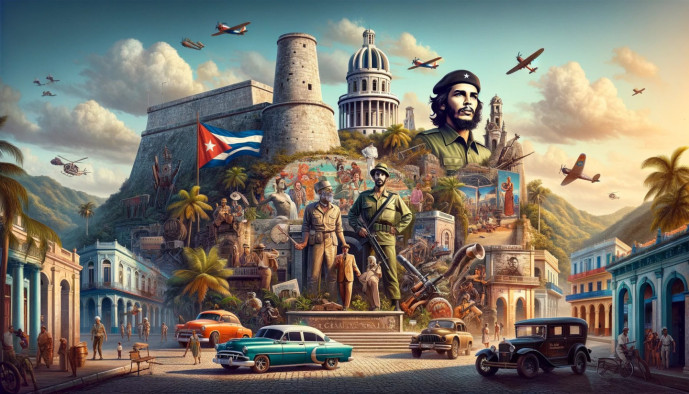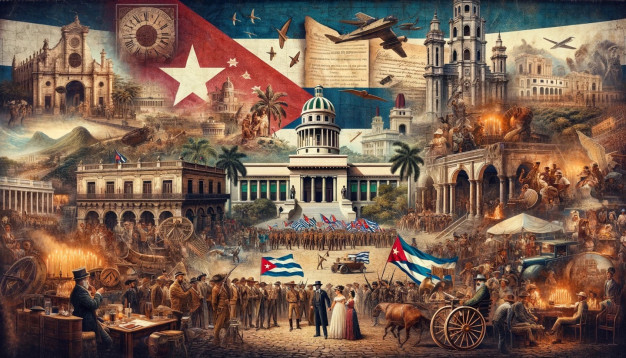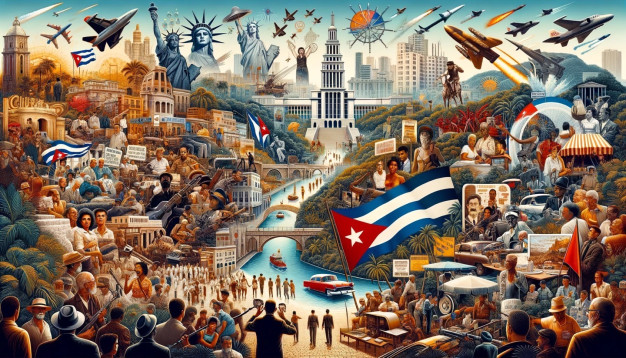Cuba History
Uncover Cuba's history: From colonial rule to the revolution

Introduction to Cuba’s Vibrant Past
Setting the Scene: Pre-Columbian Cuba
Before Columbus set foot on this lush land, Cuba was home to indigenous groups like the Taíno and Ciboney. These early inhabitants were skilled farmers, fishers, and created a rich cultural tapestry that unfortunately remains a bit of a mystery. Why? Well, because historians seem to love focusing more on the invaders than the invaded. But let’s give a nod to these original Cubans – their legacy is the foundation upon which modern Cuba is built.
Arrival of Europeans: A New Era Begins
1492, a year that changed Cuba forever. Christopher Columbus landed and, in typical European explorer fashion, claimed the island for Spain. This moment marked the beginning of a long and often brutal era of colonization, which reshaped the island’s destiny.
Colonial Cuba: Spanish Rule and Social Changes
Spain’s grip on Cuba brought about significant changes. The colonial period saw the island become a major hub for the transatlantic slave trade. This dark chapter in Cuban history is a critical piece of the puzzle in understanding the island’s diverse cultural landscape.
Economic Shifts: Sugar and Slavery
Cuba’s economy during colonial times revolved around sugar – sweet for the economy, but bitter in its reliance on slavery. Vast sugar plantations were established, operated by enslaved Africans brought to the island. This period, while economically prosperous, was marked by severe social injustices and human suffering.
Cultural Fusion: African and Spanish Influences
Despite the oppression, the blending of African and Spanish cultures gave birth to a unique Cuban identity. Music, dance, religion – these aspects of Cuban life today owe much to this fusion. It’s a classic case of resilience and cultural synthesis in the face of adversity.

The Fight for Independence
The idea of freedom started simmering in Cuba around the 19th century. The island’s patriots, inspired by independence movements across the Americas, began to dream of a Cuba libre.
Early Rebellions: Seeds of Discontent
The early rebellions, though not immediately successful, planted the seeds for future freedom struggles. These uprisings were like the awkward first steps of a child – necessary, but not quite hitting the mark.
The Ten Years’ War: A Prolonged Struggle
This was Cuba’s first serious attempt at breaking free from Spanish rule. It was a long, grueling conflict that, sadly, ended in a stalemate. But hey, no great story ever started with an easy victory, right?
José Martí and the Path to Freedom
Enter José Martí – poet, philosopher, and the George Washington of Cuba. His passion and vision for an independent Cuba galvanized the nation and laid the groundwork for eventual freedom.
American Influence and the Platt Amendment
With the Spanish-American War, the U.S. entered the Cuban narrative. Cuba was technically independent after the war, but the Platt Amendment kept the island under America’s thumb. It’s like moving out of your parents’ house but still having them pay your rent – independent, but not quite.
The Spanish-American War: A Turning Point
This conflict was a pivotal moment in Cuba’s history, ending Spanish rule but ushering in a new era of American influence. Cuba was like a coveted antique, passing from one global power to another.
Cuba Under U.S. Protectionism
The early 20th century saw Cuba under the watchful eye of Uncle Sam. This period was marked by economic growth, but also political instability. It’s a classic case of “with great power comes great responsibility” – and let’s just say the responsibility part was a bit lacking.
The Republican Era: Progress and Problems
The mid-20th century was a time of significant progress in Cuba, but also of deep-seated problems. Corruption and inequality were rampant, setting the stage for a revolution.
Political Turbulence and Corruption
Cuba’s governments during this era were about as stable as a three-legged chair. Coups, corruption, and political assassinations were the order of the day.
Cultural Renaissance: Music and Arts
But it wasn’t all doom and gloom. This period also saw a cultural renaissance in Cuba, with music and arts flourishing like never before. It’s a testament to the Cuban spirit – always finding a way to dance, even during tough times.
The Rise of Fidel Castro and the Cuban Revolution
Now we come to the part of the story that most people are familiar with – Fidel Castro and his bearded revolutionaries toppling the Batista regime.
Prelude to Revolution: Increasing Unrest
The Cuban Revolution didn’t just happen overnight. It was the culmination of years of dissatisfaction and social unrest. Think of it as a pot of discontent simmering on the stove, gradually reaching a boiling point.
Castro’s Insurrection: The Guerrilla War
Castro’s guerrilla war against Batista’s government was like something out of a movie. A small band of rebels, hiding in the mountains, eventually taking over the whole island. It’s the ultimate underdog story.
Aftermath: A New Government Takes Control
After the revolution, Castro’s government took control, and Cuba embarked on a radical journey towards socialism. It was a time of dramatic changes – land reforms, literacy campaigns, and free healthcare. A social experiment on a national scale.
Cuba Under Castro: Socialism and Struggle
Castro’s Cuba was marked by both achievements and challenges. The shift to socialism brought significant social reforms but also economic hardships.
Economic Policies and Soviet Support
Cuba’s economy during this period was heavily dependent on Soviet support. When the USSR collapsed, Cuba faced severe economic challenges. It’s like having a rich uncle who suddenly stops sending birthday checks.
Social Reforms: Education and Healthcare
One of the bright spots of Castro’s regime was the focus on education and healthcare. Cuba boasts one of the highest literacy rates and best healthcare systems in the developing world. Proof that sometimes, the most unlikely places can teach us a thing or two about social priorities.
Bay of Pigs and the Missile Crisis: Cold War Tensions
The Bay of Pigs invasion and the Cuban Missile Crisis were moments when the Cold War got a little too hot for comfort. Cuba found itself at the center of global tensions, a small island making big waves.
The Special Period: Post-Soviet Challenges
The collapse of the Soviet Union hit Cuba hard, leading to a period known as the “Special Period.” It was a time of economic crisis, but also of incredible resilience and innovation.
Economic Hardships and Innovation
During the Special Period, Cubans had to get creative to survive. Urban agriculture, innovative transportation solutions – necessity really is the mother of invention.
The Balsero Crisis: Mass Exodus
The economic hardships also led to a mass exodus of Cubans, seeking a better life elsewhere. It was a poignant reminder of the human cost of political and economic upheaval.
Contemporary Cuba: Change and Continuity
In recent years, Cuba has been slowly opening up, both economically and politically. But the road ahead is still uncertain.
Raul Castro’s Leadership: Reforms and Opening
Under Raul Castro, Fidel’s brother, Cuba began to implement modest economic reforms. It’s like finally updating a really old smartphone – it doesn’t become brand new, but it works a bit better.
U.S.-Cuba Relations: Thawing Ties
The recent thaw in U.S.-Cuba relations has been a welcome development. It’s like two old friends who stopped talking after a bad argument, finally starting to patch things up.
Cuba Today: Balancing Tradition and Modernity
Today’s Cuba is a fascinating blend of old and new. Vintage cars and colonial architecture coexist with budding entrepreneurship and increasing internet access. It’s a land of contrasts, where the past is always present.

Conclusion: Reflecting on Cuba’s Historical Journey
As we look back on Cuba’s history, we see a story of resilience, revolution, and relentless hope. From its pre-Columbian roots to its socialist present, Cuba’s journey is a testament to the strength of its people and the complexity of its culture.
Cuba’s Legacy: Resilience and Revolution
Cuba’s legacy is one of enduring spirit in the face of adversity. It’s a story that teaches us about the power of resilience, the importance of cultural identity, and the complexity of human history.
The Future of Cuba: Uncertain but Hopeful
The future of Cuba, like its past, is a mix of uncertainty and hope. As this vibrant nation continues to evolve, one thing is certain – its story will always captivate and inspire.